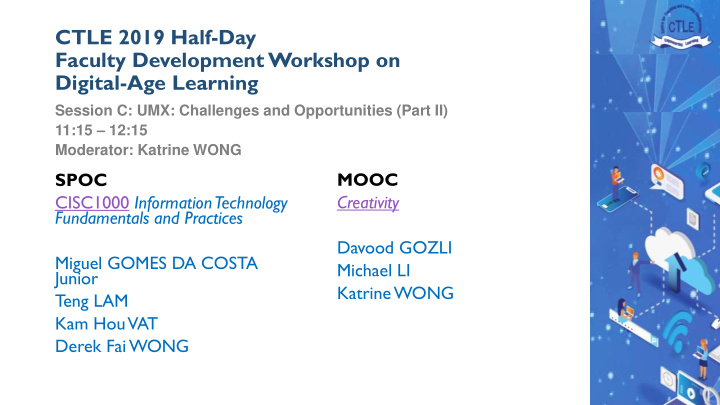



CTLE 2019 Half-Day Faculty Development Workshop on Digital-Age Learning Session C: UMX: Challenges and Opportunities (Part II) 11:15 – 12:15 Moderator: Katrine WONG SPOC MOOC CISC1000 Information Technology Creativity Fundamentals and Practices Davood GOZLI Miguel GOMES DA COSTA Michael LI Junior Katrine WONG Teng LAM Kam Hou VAT Derek Fai WONG
More information on MOOCs at UM Point of contact: CTLE Advice and support can be provided by CTLE • E.g., can help liaise with service provider, XuetangX Enquiries: Katrine WONG, kwong@um.edu.mo
CTLE 2019 Half-Day Faculty Development Workshop on Digital-Age Learning (Part II) Session D: Lessons on Revamping Large Classes with Technology 12:15 – 13:15 16 January 2019 University of Macau Lessons from Revamping a Large GE Course Prof. Yisu Zhou (FED) What's New with Student Response Systems, Google Forms, Poll Everywhere, and Rain Classroom Dr. Chris Fulton (CTLE) Moodle Tools for Large Class Sizes: the Good, the Bad, and the Ugly Prof. Garry Wong (FHS)
What's New with Student Response Systems: Google Forms, Poll Everywhere, and Rain Classroom Dr. Chris Fulton (CTLE)
Outline 1. Popular student response systems at UM 2. New features 3. How these systems are used
Popular student response systems at UM Top 6 response systems used by academic staff (2018, n=58)
New Feature in Poll Everywhere Competitions* with multiple-choice quizzes Used to generate interest and discussion, and anonymous formative assessment Questions about the syllabus Common misconceptions** Polls are now limited to 25-40 students https://youtu.be/J7DHY6kxg5I More information: * https://blog.polleverywhere.com/new-activity-competitions/ * * Verkade et al. (2017). Misconceptions as a trigger for enhancing student learning in higher education: A handbook for educators.
How Google Forms are used… Survey students’ expectations (collect feedback); student profile questionnaire level of English best time for office hours when to use laptops/phones Mid-term feedback survey; What can the students do to improve the class? What can the instructor do to improve the class?
Activity: Google Forms Scan a QR code Students answer one short answer question Teachers view responses in real time https://go.um.edu.mo/eev0v8hv
Demo: Google Forms Short answer questions, Exit ticket template Multiple-choice questions, Assessment template Q&A
How Rain Classroom works (simplified) 1. A teacher creates slides and questions in PowerPoint 2. Links WeChat account to PowerPoint 3. Uploads PPT to WeChat 4. A teacher starts the enhanced PPT for students 5. Students scan a QR code with WeChat to launch a Rain Classroom mini-program 6. Students navigate the RC mini- program to see slides and answer questions 7. T eachers see results on their phone in the RC mini-program, or in PowerPoint
New Feature in Rain Classroom
Happy to help Contact me for individual assistance • Choosing a SRS • Setting up activities/technologies chrisfulton@um.edu.mo
CTLE Half-Day Faculty Development Workshop MOODLE TOOLS FOR LARGE CLASS SIZES: THE GOOD, THE BAD, AND THE UGLY PROF. GARRY WONG, FHS JANUARY 16, 2019
The Class: GEST1002 Quantitative Reasoning for Social Sciences Class Description: GEST1002 Quantitative Reasoning for Social Sciences, Required General Education course for FSS, FED, FAH students Class Size: 2 Sections of 300 each = 600 students Teachers: 3 (Prof. Terence Poon, Prof. Vivien Wang, Prof. Wong)(FHS) Moodle Tools Used: Management - Announcements, Gradebook, Participants Activities - Attendance, Assignment, Quizzes Resources - Files
The Good Attendance, Participants, Announcements, Resources, Quizzes
The Good Attendance, Participants, Announcements, Resources, Quizzes
The Good Attendance, Participants, Announcements, Resources, Quizzes
The Bad Gradebook
The UGLY
The Summary
Thanks for your attention ! Teachers and Teaching Assistants GEST1002 Course 2018/2019-1
Recommend
More recommend